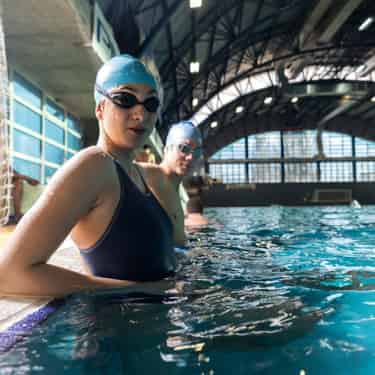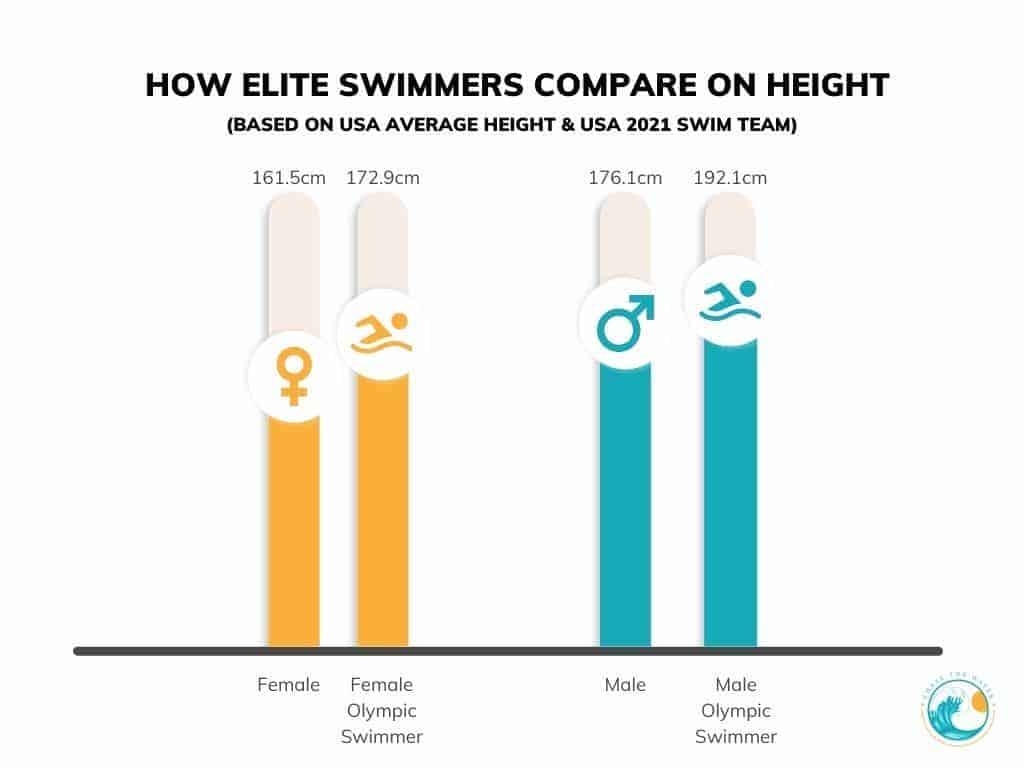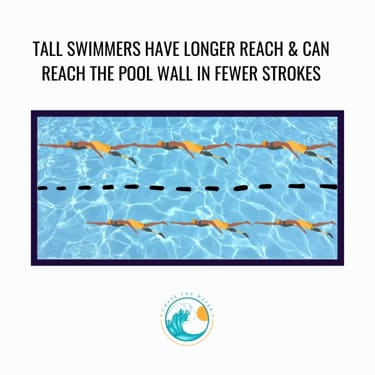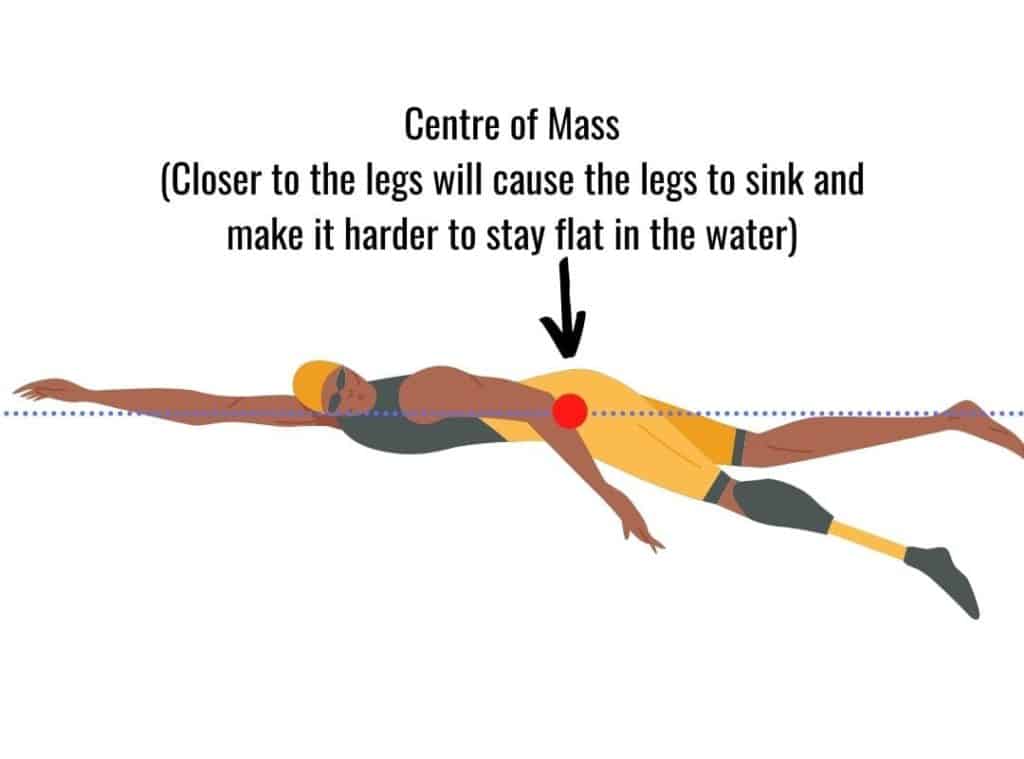As someone who is on the short side (5’1″), with very narrow feet and short arms, I often wonder if I face a significant disadvantage in the pool when it comes to swimming speed and ability.
Looking at competitive swimmers, the majority seem to be cut from the same cloth; with broad shoulders and long arms. It makes me wonder if there is a specific body type that is naturally good for swimming and if it really makes much of a difference for regular swimmers and non-Olympians?
As a general rule, a body type with a natural advantage at swimming will be tall, have a long arms to reach further and pull more water, have shorter legs to give power without excessive drag and have large hands, large feet and large lungs. These features are typically found in elite competitive swimmers.
Having certain physical attributes will give you an advantage in the water, however anybody can improve their swimming and be fast in the water with practice and careful attention placed on technique.
In this article I will look at:
- What body type is best for a swimmer and why?
- I have a bad body type for swimming. Can I still be good?

What Body Type Is Best For A Swimmer And Why?
Like all sports and activities, having a certain body type might give you advantage. For example, in basketball it helps to be tall, in football it helps to be broad and in climbing it is useful to be short.
I have noticed that all competitive swimmers have certain physical features in common. Mostly they are tall, with long arms and triangular upper body shapes.
Are these competitive swimmers similar because of extensive training of the same muscles or are they on the elite stage because the body type they were born with gave them a natural advantage in the water?
Below, I explore the body features that help you swim better, based on fluid dynamics and the shapes which move faster in the water.
Don’t be disappointed if you don’t tick any of the boxes physically (like me). Understanding what body type is best for swimming can help us understand what works in the water and what we need to work on, or change in our technique, so we can take advantage of these aspects too.
1. Height
There is a reason why tall swimmers dominate the Olympics, and that is because height matters in the pool when it comes to competitive swim times.
Below is an image showing the average height of a person in the USA (male and female) versus the average height of a professional swimmer on the 2021 USA Olympic swim team
| Gender | Average USA Height | Average USA Swim Team Height (2021) |
|---|---|---|
| Female | 5’2″ [161.5cm] | 5’6″ [172.9cm] |
| Male | 5′ 7″ [176.1cm] | 6’3″ [192.1cm] |

You can see that on average, female elite swimmers are 7% taller than the average female in the USA, and male elite swimmers are 9% taller than the average USA male.
So why is this? Why does height matter in a sport where you spend all your time in a horizontal position?
There are a few reasons why height can help you swim faster:
1. Being Long Is Good For Speed
Being long and narrow like an arrow in the water allows you to be more streamlined and, as a result, you will swim faster.
No matter what height you are, if you stretch your arms out in front of your body and make yourself as tall as possible in the water, you will swim faster because you will be more streamlined, with less drag.
Being tall and long will give you a natural advantage as size influences drag. The mechanics of swimming is covered in greater detail in the book, “World Book of Swimming”, specifically in Chapter 10, “Morphology and Swimming Performance”
But to summarise the principles from this study: [source]
- Taller swimmers will swim faster as drag is influenced by size.
- Taller swimmers create less wave resistance as they swim due to their longer length.
- Taller swimmers can potentially swim faster due to a higher hull speed.
Just a quick note on “hull speed” which is typically used to calculate the maximum speed a sailboat can travel considering the size of waves it produces. It is calculated from the following formula, which takes the square root of the length of a boat and then multiples it by a constant 1.34.
Hull Speed = LwL x 1.34
This is a very simplified explanation, but let’s imagine your “boat” is a swimmer.
Looking at different heights, you can see that taller swimmers will have a faster potential hull speed due to their length.
| Height Of Swimmer (Feet) | Hull Speed (km/h) |
|---|---|
| 5.1 | 5.6 |
| 5.6 | 5.8 |
| 6.0 | 6.0 |
| 6.3 | 6.2 |
This is why longer boats are often used as race boats as they are naturally faster. The same principle applies to swimming.
2. You Swim A Length In Less Stokes
A taller swimmer will have a shorter race distance to swim.
At 5’1″, it is going to take me a lot more swim strokes to cover the length of a pool compared to someone 6’0″ tall.
Every time a tall swimmer stretches out to take a stoke, they are closer to the swim wall than the shorter swimmers.
With greater reach, you can reach the pool wall faster than shorter competitors.

2. Long Arms (Wingspan)
When you swim, your arms act like oars. The longer and larger your arms and hands, the more water you can pull and, as a result, the faster you will swim.
Much research has been completed into the study of body measurements and how the relationship between arm length and height can be an advantage for a swimmer. [source]
In summary, swimmers with long arms in relation to their height typically do better in long-axis strokes, such as the front crawl. [source]
Longer arms will result in a longer overall height and reach in the water, which is a natural advantage as you will be faster and more streamlined, plus the extra surface area from larger hands will move more water, like using a paddle.
3. Shorter Legs
I was shocked and a little excited to learn that shorter legs can be advantageous to swimmers.
Legs create drag as you swim. If you are a beginner swimmer or at the stage of your swimming journey where you want to improve your technique or swim faster, one of the first things you must do is reduce the drag created by your legs.
If you have shorter legs, you will still have the power that legs offer, but they will create less drag in the water.
If you can keep your legs high in the water to reduce drag, yet maximise the power from a good kick, you can take advantage of shorter legs.
4. Triangular Torso
Swimmers and their “triangular” swimmer’s body is famous. If you watch any competitive swimming, you will see a common triangular body shape amongst all swimmers, both male and female.
Elite swimmers have well-defined muscles and torsos because of their extensive training and chosen sport, and this shape gives them an advantage in the water.
When you swim, it is important to stay balanced in the water. If your centre of mass (imagine this as a balancing point in the middle of your body) is closer to your legs, you will sink and create drag.
If, on the other hand, your centre of mass is closer to your lungs, you will find it easier to float flat in the water and the less effort you will have to exert to stop your legs from sinking, creating drag.

The triangular body type will have a centre-of-mass closer to the lungs, in effect making the swimmer more “top heavy”.
This will help the upper body to press down into the water and allow the legs to sit higher in the water.
The overall result is a better swimming position that is more efficient and less exhausting to hold, as your body will more naturally align in this efficient swimming position.
5. Flexibility
Shoulder and ankle flexibility is essential for fast swimming.
Although it is possible to improve flexibility, some people will have natural flexibility in their joints because of genetics.
For years I thought I had the worse swim kick in the world, but it turns out that it was not my technique but poor flexibility in my ankles that was the culprit.
With good flexibility in your ankles, you can displace more water as you kick, which results in a more power kick and faster swim time.
It is possible to increase your current level of flexibility with exercises and swim fins are often used to help improve ankle flexibility.
If you are interested in learning more about developing a power kick and improving your ankle flexibility, I have covered this in greater depth in the article, “Stretch Cord Exercises For Swimmers – Improve On Dryland“
I Have A Bad Body Type For Swimming. Can I Still Be Good?
At an elite level of swimming, where Olympic medals are on the line and fractions of seconds can mean the difference between your name in the history books or going home empty-handed, then these swimming body types are relevant.
It is no secret that Michael Phelps, one of the most decorated Olympians of all time, has a “perfect” body type to take every advantage in the pool.
If you were to make a Frankenstein swimmer in a lab, you would probably produce something that looks similar to Michael Phelps with his triangular frame, 6’4″ height, 2.01m wingspan, large 14 shoe size and hands that resemble paddles.
Outside of elite swimming, however, these body types are not relevant.
The great thing about swimming is that all body types work.
Sure, a long and top heavy frame will give you a natural advantage, but if you don’t have that advantage, you can work on your technique to press your torso into the water and stretch your body out as long as possible which will help.
Using what sports science experts have learned from the so-called “perfect body” type for swimming, we can improve our own technique in the following ways and still be great swimmers despite whatever shape or body size we have:
1. Reach For The Wall
By extending your arm out in front of you as you swim and reaching for the wall, you will extend your body to its maximum height.
As a result, you will be longer in the water and more streamlined, which will help improve your swim speed.
2. Press Your Body Into The Water
Regardless of where your centre of mass is or if you have a triangular torso, you can improve your body position by pressing your upper body and chest into the water.
By doing this, your upper body will sink and your legs will pop up.
As a result, you will create less drag and will maintain a more efficient swimming position regardless of your natural centre of mass.
3. Increase Ankle Flexibility
Having stiff ankles will affect your swim power and speed.
It is possible to increase your ankle flexibility by doing dry land exercises or wearing swim fins.
If you wear swim fins, you will get instant feedback from your ankles and experience what a powerful swim kick feels like.
Wearing swim fins also has the benefit of increasing ankle flexibility, as the extra force on the fins will stretch out your ankle.
From my personal experience, when you first start using fins, be careful not to overdo it. I made this mistake and experienced pain in my ankles because of the extra pressure of the fins.
4. Rotate Your Hips
If you find it difficult to swim due to body shape, try to rotate your hips as much as possible as you swim.
By swimming with your hips, you will find it easier to propel yourself through the water.
Final Thoughts
All this analysis from sports science experts on the best body for swimming can be disheartening if you don’t find yourself in that group.
Personally, I am short, with a tiny wingspan, stiff ankles and a poor centre of mass. Despite that, I love to swim.
On paper, I am the opposite of what a good swimmer’s body is, but I still find strengths I can call upon, such as stamina and strong lungs.
I have found that learning from this research and improving my technique to get the most out of what I already have is the best approach to improving my swimming.
For everyday regular swimmers who are not seeking an Olympic medal, we should not be looking at our body shape and thinking “oh well, I guess I will never swim as I don’t fit the swimmer body type”.
All body types work in the water and how fast you go, or how well you swim depends on your swim technique and how well you use the strengths you do have, even if they are not on the perfect swimmer’s body list.
Happy swimming!
